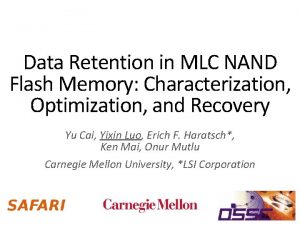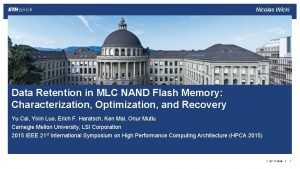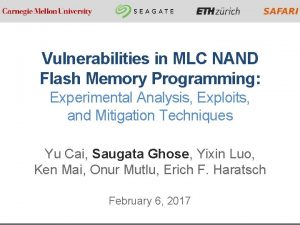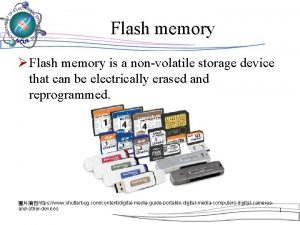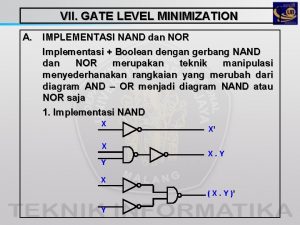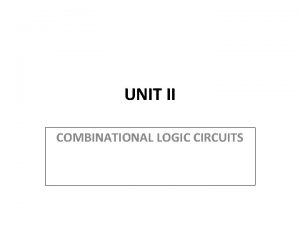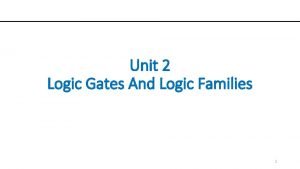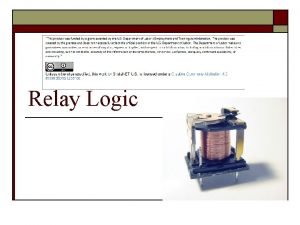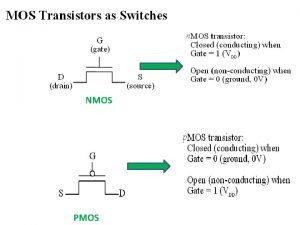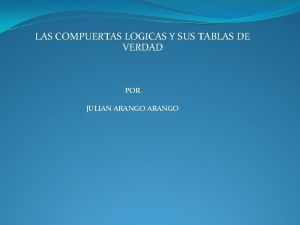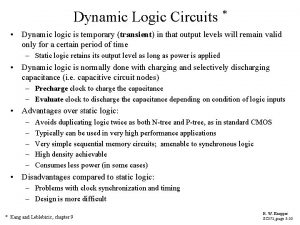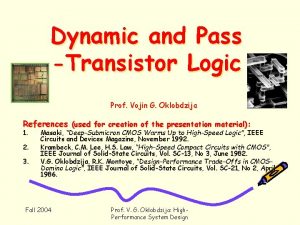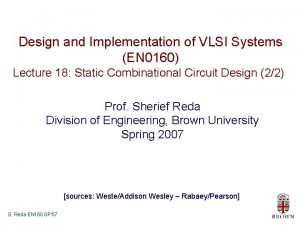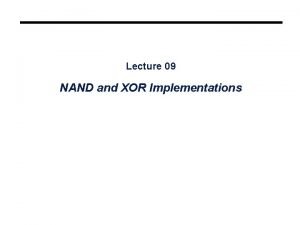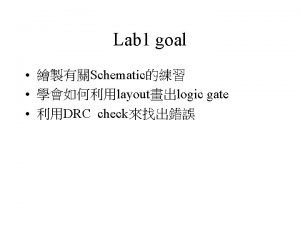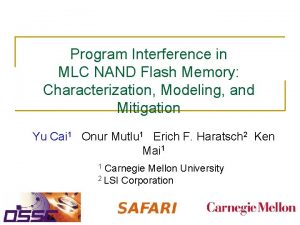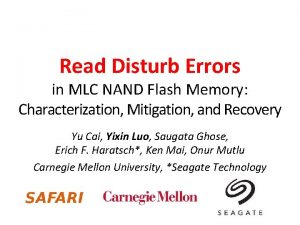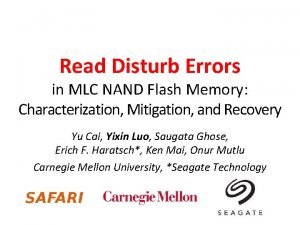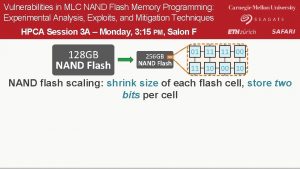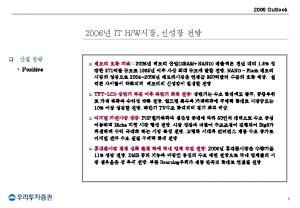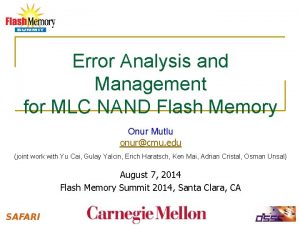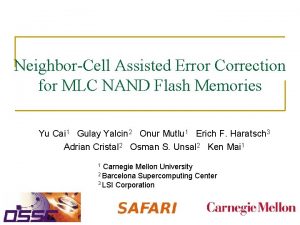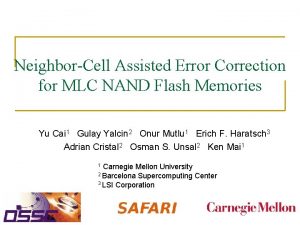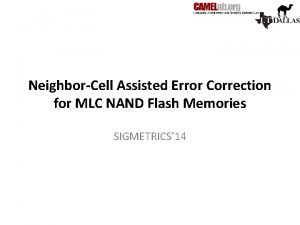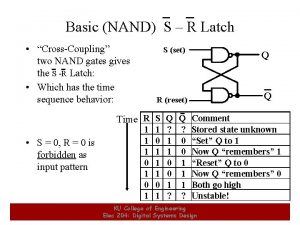Data Retention in MLC NAND Flash Memory Characterization


















![Characterization Methodology FPGA-based flash memory testing platform [Cai+, FCCM ‘ 11] 19 Characterization Methodology FPGA-based flash memory testing platform [Cai+, FCCM ‘ 11] 19](https://slidetodoc.com/presentation_image/27e088ecad56ce3413fce0f1446ca4b0/image-19.jpg)


































- Slides: 53

Data Retention in MLC NAND Flash Memory: Characterization, Optimization, and Recovery Yu Cai, Yixin Luo, Erich F. Haratsch*, Ken Mai, Onur Mutlu Carnegie Mellon University, *LSI Corporation 1

You Probably Know • Many use cases: + High performance, low energy consumption 2

NAND Flash Memory Challenges CPU Flash Controller – Requires erase before program (write) – High raw bit error rate Raw Flash Memory Chips ECC Controller 3

n o i t lifetime Goal: Extend flash memory a r e n e g at low cost r e w e N ~3000 P/E Cycle Lifetime ECC-correctable RBER ~2000 Raw bit error rate (RBER) Limited Flash Memory Lifetime Program/Erase (P/E) Cycles (or Writes Per Cell) 4

Retention Loss Charge leakage over time 0 0 Flash cell 1 Retention error One dominant source of flash memory errors [DATE ‘ 12, ICCD ‘ 12] 5

Before I show you how we extend flash lifetime … NAND Flash 101 6

Threshold Voltage (Vth) Flash cell 1 0 Normalized Vth 7

Threshold Voltage (Vth) Distribution Probability Density Function (PDF) 1 0 Normalized Vth 8

Read Reference Voltage (Vref) PDF Vref 1 0 Normalized Vth 9

P 2 (00) P 2‐P 3 Vref P 1 (10) P 1‐P 2 Vref ER‐P 1 Vref PDF Erased (11) Multi‐Level Cell (MLC) P 3 (01) Normalized Vth 10

Threshold Voltage Reduces Over Time Before After some retention loss: PDF P 1 (10) P 2 (00) P 3 (01) Normalized Vth 11

Fixed Read Reference Voltage Becomes Suboptimal P 1 (10) P 2 (00) Raw bit errors P 2‐P 3 Vref PDF P 1‐P 2 Vref Before After some retention loss: P 3 (01) Normalized Vth 12

P 1 (10) P 2 (00) P 2‐P 3 OPT P 2‐P 3 Vref PDF P 1‐P 2 OPT P 1‐P 2 Vref Optimal Read Reference Voltage (OPT) After some retention loss: Minimal raw bit errors P 3 (01) Normalized Vth 13

Goal 1: Design a low‐cost mechanism that dynamically finds the optimal read reference voltage 14

Retention Failure P 1 (10) P 2 (00) P 2‐P 3 Vref PDF P 1‐P 2 Vref some retention loss: After significant retention Uncorrectable errors Correctable errors P 3 (01) Normalized Vth 15

Goal 1: Design a low‐cost mechanism that dynamically finds the optimal read reference voltage Goal 2: Design an offline mechanism to recover data after detecting uncorrectable errors 16

To understand the effects of retention loss: ‐ Characterize retention loss using real chips 17

To understand the effects of retention loss: ‐ Characterize retention loss using real chips Goal 1: Design a low‐cost mechanism that dynamically finds the optimal read reference voltage Goal 2: Design an offline mechanism to recover data after detecting uncorrectable errors 18
![Characterization Methodology FPGAbased flash memory testing platform Cai FCCM 11 19 Characterization Methodology FPGA-based flash memory testing platform [Cai+, FCCM ‘ 11] 19](https://slidetodoc.com/presentation_image/27e088ecad56ce3413fce0f1446ca4b0/image-19.jpg)
Characterization Methodology FPGA-based flash memory testing platform [Cai+, FCCM ‘ 11] 19

Characterization Methodology • FPGA-based flash memory testing platform • Real 20 - to 24 -nm MLC NAND flash chips • 0 - to 40 -day worth of retention loss • Room temperature (20⁰C) • 0 to 50 k P/E Cycles 20

Characterize the effects of retention loss 1. Threshold Voltage Distribution 2. Optimal Read Reference Voltage 3. RBER and P/E Cycle Lifetime 21

PDF 1. Threshold Voltage (Vth) Distribution P 1 P 2 P 3 Normalized Vth 22

1. Threshold Voltage (Vth) Distribution 0‐day 40‐day P 1 P 2 P 3 Finding: Cell’s threshold voltage decreases over time 23

2. Optimal Read Reference Voltage (OPT) 40‐day OPT P 1 40‐day OPT P 2 P 3 Finding: OPT decreases over time 24

RBER 3. RBER and P/E Cycle Lifetime P/E Cycles 25

3. RBER and P/E Cycle Lifetime Extended Lifetime Nominal Lifetime Vref closer to Reading data with 7 -day worth of retention loss. actual OPT Actual OPT ECC-correctable RBER Finding: Using actual OPT achieves the longest lifetime 26

Characterization Summary Due to retention loss ‐ Cell’s threshold voltage (Vth) decreases over time ‐ Optimal read reference voltage (OPT) decreases over time Using the actual OPT for reading ‐ Achieves the longest lifetime 27

To understand the effects of retention loss: ‐ Characterize retention loss using real chips Goal 1: Design a low‐cost mechanism that dynamically finds the optimal read reference voltage Goal 2: Design an offline mechanism to recover data after detecting uncorrectable errors 28

Naïve Solution: Sweeping Vref Key idea: Read the data multiple times with different read reference voltages until the raw bit errors are correctable by ECC Finds the optimal read reference voltage Requires many read-retries higher read latency 29

Comparison of Flash Read Techniques Fixed Vref Sweeping Vref Our Goal Lifetime (P/E Cycle) Performance (Read Latency) 30

Observations 1. The optimal read reference voltage gradually decreases over time Key idea: Record the old OPT as a prediction (Vpred) of the actual OPT Benefit: Close to actual OPT Fewer read retries 2. The amount of retention loss is similar across pages within a flash block Key idea: Record only one Vpred for each block Benefit: Small storage overhead (768 KB out of 512 GB) 31

Retention Optimized Reading (ROR) Components: 1. Online pre-optimization algorithm ‐ Periodically records a Vpred for each block 2. Improved read-retry technique ‐ Utilizes the recorded Vpred to minimize read-retry count 32

1. Online Pre‐Optimization Algorithm • Triggered periodically (e. g. , per day) • Find and record an OPT as per-block Vpred • Performed in background • Small storage overhead PDF New Vpred Old Vpred Normalized Vth 33

2. Improved Read‐Retry Technique • Performed as normal read • Vpred already close to actual OPT • Decrease Vref if Vpred fails, and retry PDF OPT Vpred Very close Normalized Vth 34

Retention Optimized Reading: Summary Flash Read Techniques Fixed Vref Sweeping Vref ROR Lifetime (P/E Cycle) 64% ↑ Performance (Read Latency) _____ Nom. Life: 2. 4% ↓ Ext. Life: 70. 4% ↓ 35

To understand the effects of retention loss: ‐ Characterize retention loss using real chips Goal 1: Design a low‐cost mechanism that dynamically finds the optimal read reference voltage Goal 2: Design an offline mechanism to recover data after detecting uncorrectable errors 36

Retention Failure P 1 (10) P 2 (00) P 2‐P 3 Vref PDF P 1‐P 2 Vref After some significant retention After retention loss: Uncorrectable errors Correctable errors P 3 (01) Normalized Vth 37

Leakage Speed Variation PDF S low‐leaking cell F ast‐leaking cell Normalized Vth 38

Initially, Right After Programming PDF P 2 P 3 S S F F F S Normalized Vth 39

PDF After Some Retention Loss Fast-leaking cells have lower Vth P 2 Slow-leaking cells have higher P 3 Vth S S F F F S Normalized Vth 40

Eventually: Retention Failure PDF P 2 OPT P 3 S S F F S S Normalized Vth 41

Retention Failure Recovery (RFR) Key idea: Guess original state of the cell from its leakage speed property Three steps 1. Identify risky cells 2. Identify fast-/slow-leaking cells 3. Guess original states 42

OPT+σ OPT–σ PDF 1. Identify Risky Cells S F P 2 Risky + S = cells + F = P 3 Key Formula F S Normalized Vth 43

OPT+σ OPT PDF OPT–σ 2. Identifying Fast‐ vs. Slow‐Leaking Cells ? ? P 2 Risky + S = cells + F = P 3 Key Formula ? ? Normalized Vth 44

S? ? ? OPT+σ PDF OPT–σ 2. Identifying Fast‐ vs. Slow‐Leaking Cells ? F P 2 Risky + S = cells + F = P 3 Key Formula ? F S? Normalized Vth 45

3. Guess Original States P 2 Risky + S = cells + F = P 3 Key Formula PDF S F F S Normalized Vth 46

RFR Evaluation Program with random data 28 days Detect failure, backup data • Expect to eliminate 50% of raw bit errors • ECC can correct remaining errors 12 addt’l. days Recover data 47

To understand the effects of retention loss: ‐ Characterize retention loss using real chips Goal 1: Design a low‐cost mechanism that dynamically finds the optimal read reference voltage Goal 2: Design an offline mechanism to recover data after detecting uncorrectable errors 48

Conclusion Problem: Retention loss reduces flash lifetime Overall Goal: Extend flash lifetime at low cost Flash Characterization: Developed an understanding of the effects of retention loss in real chips Retention Optimized Reading: A low-cost mechanism that dynamically finds the optimal read reference voltage ‐ 64% lifetime ↑, 70. 4% read latency ↓ Retention Failure Recovery: An offline mechanism that recovers data after detecting uncorrectable errors ‐ Raw bit error rate 50% ↓, reduces data loss 49

Data Retention in MLC NAND Flash Memory: Characterization, Optimization, and Recovery Yu Cai, Yixin Luo, Erich F. Haratsch*, Ken Mai, Onur Mutlu Carnegie Mellon University, *LSI Corporation 50

Backup Slides 51

RFR Motivation Data loss can happen in many ways 1. High P/E cycle 2. High temperature accelerates retention loss 3. High retention age (lost power for a long time) 52

What if there are other errors? Key: RFR does not have to correct all errors Example: • ECC can correct 40 errors in a page • Corrupted page has 20 retention errors, 25 other errors (45 total errors) • After RFR: 10 retention errors, 30 other errors (40 total errors ECC correctable) 53
 Nand data retention
Nand data retention Flash memory architecture
Flash memory architecture Data retention flash
Data retention flash Digital photography with flash and no-flash image pairs
Digital photography with flash and no-flash image pairs Mlc index plus balanced portfolio
Mlc index plus balanced portfolio Capacity planning ibm i
Capacity planning ibm i Www.gaga
Www.gaga Mlc exsum example
Mlc exsum example Mlc adviser
Mlc adviser Mlc 8000
Mlc 8000 Mlc 2006
Mlc 2006 Mlc global share fund
Mlc global share fund All blocks
All blocks Measuring device
Measuring device Memory-driven computing
Memory-driven computing Nonvolatile storage
Nonvolatile storage Toshiba flash 1980
Toshiba flash 1980 Uil music memory
Uil music memory Meaning of direct characterization
Meaning of direct characterization Indirect and direct characterization
Indirect and direct characterization Azure data protection
Azure data protection Semantics prototype
Semantics prototype Excplicit memory
Excplicit memory Long term memory vs short term memory
Long term memory vs short term memory Internal memory and external memory
Internal memory and external memory Primary memory and secondary memory
Primary memory and secondary memory Logical and physical address in os
Logical and physical address in os Which memory is the actual working memory?
Which memory is the actual working memory? Page fault
Page fault Virtual memory in memory hierarchy consists of
Virtual memory in memory hierarchy consists of Eidetic memory vs iconic memory
Eidetic memory vs iconic memory Symmetric shared memory architecture
Symmetric shared memory architecture Gate level minimization
Gate level minimization In/out
In/out Not gate boolean expression
Not gate boolean expression Nand gate with relays
Nand gate with relays Nmos nand gate
Nmos nand gate A nand b
A nand b Logic
Logic Compuertas logicas tablas
Compuertas logicas tablas Nand 2 tetris
Nand 2 tetris Dynamic nand gate
Dynamic nand gate Dynamic pass transistor
Dynamic pass transistor Boolean algebra nand
Boolean algebra nand 2 input nand gate using pass transistor logic
2 input nand gate using pass transistor logic Operation of ttl nand gate
Operation of ttl nand gate Tabel kebenaran gerbang logika and
Tabel kebenaran gerbang logika and Damian gates
Damian gates Multilevel nand gate
Multilevel nand gate Dynamic nand gate
Dynamic nand gate Not or
Not or Nand to xor gate conversion
Nand to xor gate conversion Nor layout
Nor layout Tabel kebenaran gerbang logika
Tabel kebenaran gerbang logika
